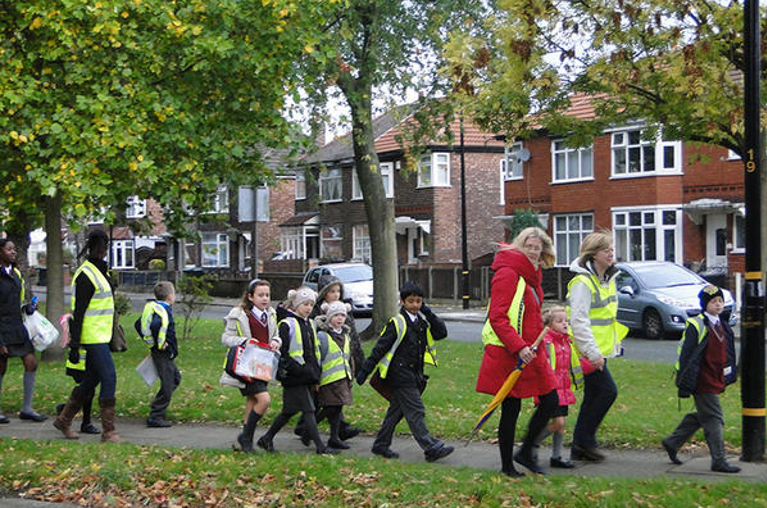Here’s the problem: Fears for children’s safety during their commute to school means fewer students are riding bikes or walking to school. More students are being driven to school, which results in more traffic, further eroding students’ ability to make their way to school safely. This also contributes to traffic congestion, increased pressure on time-pressed parents and guardians, and lost opportunities for physical activity for students.
Here’s how one organization is working on the problem: Conceived by Australian creative planner and urbanist David Engwicht in 1992, the Walking School Bus is an agreed, set route to and from school supervised by adult volunteer “drivers” (often parents) who collect students from various stops. The bus is free, and every child is welcome, whether or not they have a parent who can be a driver.
The Walking School Bus can be as simple and low cost, or as elaborate, as the students and volunteers wish to make it. A ratio of one adult to eight students is recommended. Benefits to students include learning to negotiate the road and their neighborhood, improving social interaction, and getting physical exercise. Benefits to parents include reducing fuel costs, saving time, and gaining peace of mind in knowing that their children are going to school safely. The Walking School Bus often has the support of a local authority and/or the school, but can be self-organized and run by parents and students. The Bicycle Train is a version of the Walking School Bus where the mode of transport is cycling.
Results:
- The Walking School Bus has become a global phenomenon, widely adopted in the U.K. and other parts of Europe, Australia, New Zealand, and the U.S.
- In 2010, Western Australia had established 39 active Walking School Bus routes at 26 primary schools. Routes are approximately six miles, and surveys revealed that there were more than 10,000 “trips” made in the first three terms of the year. During the same period, these efforts saved nearly 3.5 tons of greenhouse gas emissions.
- Auckland has over 350 active walking school buses, with more than 4,000 children walking to school.
- A 2011 study published in the Pediatrics journal revealed that children who were randomly chosen to participate in a Walking School Bus over a five-week period in Houston, Texas, increased their weekly rate of active commuting by an average of 38 percent.
Learn more from:
- The Walking School Bus: A Guide for Parents and Teachers
- Simple Guide to Starting a Walking School Bus
This case study is adapted from our latest book, “Sharing Cities: Activating the Urban Commons.” Get a copy today.
This article is cross posted with permission from Shareable.net.





